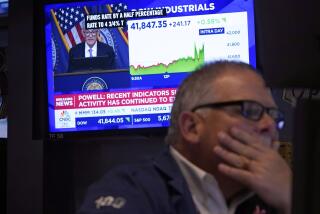The Fed’s tea leaves
IT’S NO WONDER Federal Reserve Chairman Ben S. Bernanke and his colleagues on the Open Market Committee choose their words carefully. Wall Street reacts as much to what they don’t say as to what they do.
On Wednesday, the committee concluded its latest meetings by declaring that it would leave its benchmark interest rate at 5.25%. That’s been the Fed’s policy for nine months, after two years of ratcheting up rates. The committee’s statement also reiterated two things it has been saying for months: The economy is likely to keep expanding at a moderate pace and inflation remains the central bank’s main concern.
What was omitted, however, was the usual reference to “additional firming that may be needed” -- Federal Reservese for raising interest rates, a formulation that had been included in every committee statement since June 2006.
Wall Street reacted with the financial equivalent of popping champagne corks. The Dow Jones industrial average jumped almost 160 points, while the Nasdaq and S&P; 500 indexes posted even larger percentage gains. Traders interpreted the Fed’s message as a sign that lower rates were on the way, the sort of news that sparks a rally.
The real message in the tea leaves, though, is murkier than the trading day suggested. In late January, the committee had sounded cautiously optimistic about the national housing market stabilizing; on Wednesday, it said, darkly, that the “adjustment” in the sector was continuing apace. That adjustment -- downward -- has been fueled of late by the collapse in the sub-prime lending sector, and some economists predict that other sectors will soon follow. Home builders are taking a beating, and typically a decline in construction hurts sales of durable goods. Should the problems in the housing market spill over into the larger economy, the Fed may very well cut rates to stimulate growth.
On the other hand, the committee also noted that core inflation -- the increase in prices for goods and services other than energy and housing -- was on the rise once more, with other economic conditions likely to continue exerting inflationary pressure. One example: Productivity growth is slowing but wages are rising, potentially driving manufacturers to raise prices. Such forces argue in favor of the Fed raising rates.
Given these countervailing concerns, the committee may have been silent on “additional firming” just to give itself more flexibility to go either way on interest rates rather than to signal an inclination to lower them. Wall Street, which has reacted harshly to the collapse of the sub-prime lending sector, seems to think the Fed is preparing to gallop to the rescue. But judging from what the committee actually said, the Federal Reserve can’t tell yet which distress signals, if any, to respond to.
More to Read
Inside the business of entertainment
The Wide Shot brings you news, analysis and insights on everything from streaming wars to production — and what it all means for the future.
You may occasionally receive promotional content from the Los Angeles Times.










